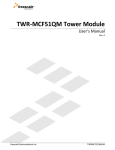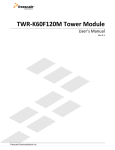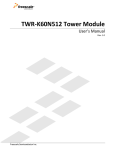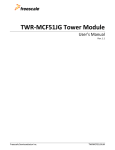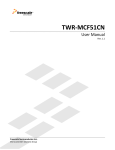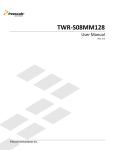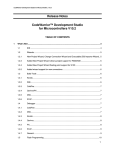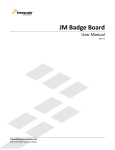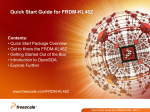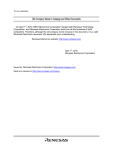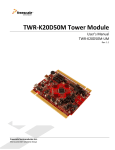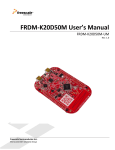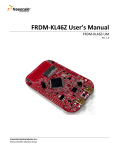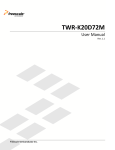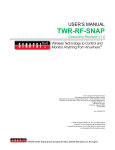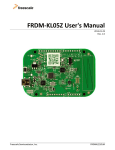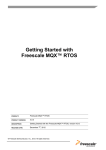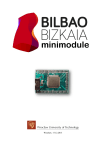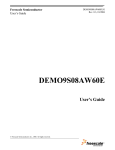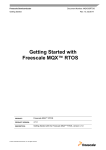Download TWR-MCF51JF Tower Module
Transcript
TWR-MCF51JF Tower Module User's Manual Rev. 0 Freescale Semiconductor Inc. TWRMCF51JFUM Table of Contents 1 TWR-MCF51JF and TWR-MCF51JF-KIT Overview ........................................................................4 1.1 Contents .................................................................................................................................................................................. 4 1.2 Features .................................................................................................................................................................................. 5 1.3 Getting Started ..................................................................................................................................................................... 6 1.4 Reference Documents ....................................................................................................................................................... 6 2 Hardware Description ...........................................................................................................................6 2.1 MCF51JF Microcontroller ................................................................................................................................................ 7 2.2 Clocking .................................................................................................................................................................................. 8 2.3 System Power ....................................................................................................................................................................... 8 2.4 Debug Interface ................................................................................................................................................................ 10 2.4.1 OSBDM ................................................................................................................................................................................................. 10 2.5 Infrared Port ...................................................................................................................................................................... 10 2.6 Accelerometer ................................................................................................................................................................... 11 2.7 Potentiometer, Pushbuttons, LEDs .......................................................................................................................... 11 2.8 Microphone ........................................................................................................................................................................ 11 2.9 Audio Output ..................................................................................................................................................................... 12 2.10 General Purpose Tower Plug-in (TWRPI) Socket ............................................................................................ 12 2.11 Touch Interface .............................................................................................................................................................. 13 2.12 USB ...................................................................................................................................................................................... 14 2.13 External Bus Interface – FlexBus ............................................................................................................................ 15 3 Jumper Table.......................................................................................................................................... 15 4 Input/Output Connectors and Pin Usage Table ......................................................................... 16 5 Tower Elevator Connections ............................................................................................................ 17 TWRMCF51JFUM TWR-MCF51JF Tower Module User's Manual Page 2 of 19 List of Figures Figure 1. Freescale Tower System Overview .............................................................................................. 4 Figure 2. Callouts on front side of the TWR-MCF51JF ................................................................................ 6 Figure 3. TWR-MCF51JF Block Diagram ...................................................................................................... 7 Figure 4. Main Oscillator Input ................................................................................................................... 8 Figure 5. Infrared Port Implementation ................................................................................................... 11 Figure 6. Accelerometer Circuit ................................................................................................................ 11 Figure 7. Microphone circuit ..................................................................................................................... 12 Figure 8. Audio output (DAC) circuit ......................................................................................................... 12 Figure 9. USB dual-role interface .............................................................................................................. 14 List of Tables Table 1. General Purpose TWRPI socket pinout ....................................................................................... 13 Table 2. Touch TWRPI socket pinout ........................................................................................................ 13 Table 3. TWR-MCF51JF Jumper Table....................................................................................................... 15 Table 4. I/O Connectors and Pin Usage Table........................................................................................... 16 Table 5. TWR-MCF51JF Primary Connector Pinout .................................................................................. 17 Revision History Revision 0 TWRMCF51JFUM Date May 23, 2010 Changes Initial Release TWR-MCF51JF Tower Module User's Manual Page 3 of 19 1 TWR-MCF51JF and TWR-MCF51JF-KIT Overview The TWR-MCF51JF is a Tower Controller Module compatible with the Freescale Tower System. It can function as a stand-alone, low-cost platform for the evaluation of the ColdFire+ MCF51JU and MCF51JF microcontroller (MCU) devices. The TWR-MCF51JF features the MCF51JF, a ColdFire+ 32-bit microcontroller built on the Version 1 (V1) ColdFire® core and enabled by innovative 90nm thin film storage (TFS) flash process technology with FlexMemory. The MCF51Jx families offer a rich combination of additive peripherals including USB, hardware encryption, an innovative touch sensing interface (TSI), and more. The TWR-MCF51JF is available as a stand-alone product or as a kit (TWR-MCF51JF-KIT) with the Tower Elevator Modules (TWR-ELEV) and the Tower Prototyping Module (TWR-PROTO). The TWR-MCF51JF can also be combined with other Freescale Tower peripheral modules to create development platforms for a wide variety of applications. Figure 1 provides an overview of the Freescale Tower System. Figure 1. Freescale Tower System Overview 1.1 Contents The TWR-MCF51JF contents include: TWR-MCF51JF board assembly TWRMCF51JFUM TWR-MCF51JF Tower Module User's Manual Page 4 of 19 3ft A to mini-B USB cable for debug interface and power 3ft A to micro-B USB cable for MCF51JF USB interface Micro-B to A adapter for MCF51JF USB Host applications Interactive DVD with software installers and documentation Quick Start Guide The TWR-MCF51JF-KIT contains: TWR-MCF51JF MCU module TWR-ELEV – Primary and Secondary Elevator Modules TWR-PROTO – Prototyping module 1.2 Features Figure 2 shows the TWR-MCF51JF with some of the key features called out. The following list summarizes the features of the TWR-MCF51JF Tower MCU Module: Tower compatible microcontroller module MCF51JF128VLH: MCF51JF with 128 Kbytes of flash in a 64 pin LQFP package Dual role USB interface with Micro-AB USB connector Touch Tower Plug-in Socket General purpose Tower Plug-in (TWRPI) socket On-board debug circuit (OSBDM) with virtual serial port Three axis accelerometer (MMA8451Q) Two (2) user-controllable LEDs Two (2) capacitive touch pads One (1) user pushbutton switch Infrared transmit and receive Potentiometer Microphone (ADC) and audio output (DAC) TWRMCF51JFUM TWR-MCF51JF Tower Module User's Manual Page 5 of 19 Figure 2. Callouts on front side of the TWR-MCF51JF 1.3 Getting Started Follow the Quick Start Guide found printed in the TWR-MCF51JF box or the interactive DVD for the list of recommended steps for getting started. Check for new or revised documentation on the tool support page for the TWR-MCF51JF: http://www.freescale.com/TWR-MCF51JF. 1.4 Reference Documents The documents listed below should be referenced for more information on the ColdFire+ devices, Freescale Tower System, and the TWR-MCF51JF Controller Module. These can be found in the documentation section of freescale.com/TWR-MCF51JF or freescale.com/coldfire+. TWR-MCF51JF-QSG: Quick Start Guide TWR-MCF51JF-SCH: Schematics TWR-MCF51JF-PWA: Design Package ColdFire+ Portfolio Product Brief MCF51JF128 Reference Manual MCF51JU128 Reference Manual Tower Configuration Tool Tower Mechanical Drawing 2 Hardware Description The TWR-MCF51JF is a Tower Controller Module featuring the MCF51JF128—a ColdFire+ based microcontroller with USB 2.0 full-speed OTG controllers in a 64 LQFP package. It is intended for use in the Freescale Tower System but can operate stand-alone. An on-board debug circuit, OSBDM, provides a BDM interface and a power supply input through a single USB mini-AB connector. Figure 3 TWRMCF51JFUM TWR-MCF51JF Tower Module User's Manual Page 6 of 19 shows a block diagram of the TWR-MCF51JF. The following sections describe the hardware in more detail. Tower Elevator Expansion Connectors I2S, SPI, I2C, ADC, USB, DAC, PWM, SCI/UART, Flexbus 5.0V 3.3V 8 MHz XTAL 5.0V USB Mini-B OSBDM BDM, Power, SCI USB Micro-AB IR Output Comparator BDM SCI MCF51JF128 64-pin LQFP USB GPIO / Interrupts LED Reset TSI ADC ADC, DAC LED Cap Touch Pads TSI, GPIO I2C SPI, I2C, ADC, GPIO Infrared Port Microphone & DAC Output Freescale Device General Purpose Tower Plug-in (TWRPI) Touch Tower Plug-in (TWRPI) MMA8451Q External Connectors Interface Circuits Power Figure 3. TWR-MCF51JF Block Diagram 2.1 MCF51JF Microcontroller The TWR-MCF51JF module features the MCF51JF128VLH. The key features of the microcontroller are listed here: 32-bit ColdFire+ core with FlexMemory, EMAC, and DIV hardware acceleration 50 MHz maximum core operating frequency 64-pin LQFP, 9mm x 9mm 1.71V – 3.6V operating voltage input range 128 Kbytes of program flash, 32 Kbytes of static RAM FlexMemory consisting of 32 Kbytes of FlexMemory that can be used as additional non-volatile flash or up to 2KB of enhanced EEPROM. 10 flexible low power modes, ideal for extending battery life Cryptographic Acceleration Unit (CAU) and Random Number Generator (RNGB) for secure communications Integrated capacitive touch sensing support: low power touch sensing interface (TSI) Integrated USB 2.0 Full-Speed Device/Host/OTG Controller supporting connection via USB and battery charging Serial audio interface (SAI) providing a direct interface to codecs and to Inter-IC Sound (I2S) audio devices TWRMCF51JFUM TWR-MCF51JF Tower Module User's Manual Page 7 of 19 Real-time debug support, with six hardware breakpoints that can be configured to halt the processor or generate debug interrupt External bus interface Multi-purpose clock generator with PLL and FLL operation modes; multiple input oscillator or resonator frequency ranges; two internal trimmable references 12-bit SAR ADC (up to 17 single-ended channels), 12-bit DAC High-speed analog comparator with 6-bit DAC Programmable voltage reference SPI, I2C (w/ SMBUS support), UART (w/ ISO7816 and IrDA), GPIO with pin interrupt support, DMA request capability, digital glitch filtering 2.2 Clocking The ColdFire+ MCUs start up from an internal digitally controlled oscillator (DCO). Software can enable the main external oscillator (EXTAL2/XTAL2) if desired. The external oscillator/resonator for the Multipurpose Clock Generator (MCG) module can range from 32.768 KHz up to a 32 MHz. The TWR-MCF51JF provides an 8 MHz ceramic resonator as shown in Figure 4 below and sheet 4 of the schematics. Figure 4. Main Oscillator Input 2.3 System Power When installed into a Tower System, the TWR-MCF51JF can be powered from either an on-board source or from another source in the assembled Tower System. In stand-alone operation, the main power source for the TWR-MCF51JF module is derived from the 5.0V input from either the OSBDM USB mini-B connector (J19), the MCF51JF USB micro-AB connector (J15), or the EzPort header (J21) when a shunt is placed on jumper J24. Two low-dropout regulators provide 3.3V and 1.8V supplies from the 5.0V input voltage. Additionally, the 3.3V regulator built into the MCF51JF can be selected. All the user selectable options can be configured using two headers, J13 and J14. The J13 header is used to select the power source that is supplied to one of the three possible voltage regulators. The J14 header is used to select the regulated board power source. Refer to Table 1 and Table 2 for details. TWRMCF51JFUM TWR-MCF51JF Tower Module User's Manual Page 8 of 19 Table 1. J13, Regulator Power Source Selection J13 Shunt Setting 2 Description 8 1 7 2 8 1 7 2 8 1 7 2 8 1 7 1-2 Power from the OSBDM interface (J19) supplied to the onboard voltage regulators. This is a default setting. 5-6 Power from the MCF51JF USB device interface (J15) supplied to the MCF51JF on-chip regulator. This is a default setting. 6-8 Power from the Tower Primary Connector USB device interface supplied to the MCF51JF on-chip regulator. 3-5 2-4 Power from the MCF51JF USB device interface (J15) supplied to the on-board voltage regulators. Table 2. J14, Board Power Source Selection J14 Shunt Setting 2 Description 8 1 7 2 8 1 7 2 8 1 8 1 7 1 TWRMCF51JFUM Board power is supplied by the 3.3V on-board (external) regulator. This is the default setting. 5-7 Board power is supplied by the 1.8V on-board (external) regulator. 1-2 Board power is supplied by the 3.3V MCF51JF on-chip (internal) regulator. 1-3 5-7 Power from the 3.3V MCF51JF on-chip (internal) regulator is supplied to the 1.8V on-board (external) regulator. Board power is supplied by the 1.8V on-board (external) regulator. Note: Take care not to install a shunt on J13 pins 1-2 when J14 is in this configuration. It is recommended to remove the shunt from J13 1-2 and use it on J14 for this setting. ― An external battery or other alternate source can be connected to pins 5 (positive) and 6 (negative, ground). 7 2 2 3-5 ― + 8 7 TWR-MCF51JF Tower Module User's Manual Page 9 of 19 The 3.3V or 1.8V power supplied to the MCU is routed through a jumper, J18. The jumper shunt can be removed to allow for either 1) alternate MCU supply voltages to be injected or 2) the measurement of power consumed by the MCU. 2.4 Debug Interface There are two debug interface options provided: the on-board OSBMD circuit and an external Background Debug Mode (BDM) connector. The BDM connector is a standard 6-pin connector providing an external debugger cable with access to the BDM interface of the MCF51JF128. Alternatively, the on-board OSBDM debug interface can be used to access the debug interface of the MCF51JF128. 2.4.1 OSBDM An on-board MC9S08JM60 based Open Source BDM (OSBDM) circuit provides a BDM debug interface to the MCF51JF. A standard USB A male to mini-B male cable (provided) can be used for debugging via the USB connector, J19. The OSJTAG interface also provides a USB to serial bridge. Drivers for the OSBDM interface are provided in the P&E Micro OSBDM/OSJTAG Tower Toolkit (available on the included DVD). These drivers and more utilities can be found online at http://www.pemicro.com/osbdm. 2.5 Infrared Port An infrared transmit and receive interface is implemented as shown in Figure 5 below. The CMT_IRO pin directly drives an infrared diode. The receiver uses an infrared phototransistor connected to an onchip analog comparator through a low-pass filter. Internal to the MCF51JF device, the output of the analog comparator can be routed to a UART module for easier processing of the incoming data stream. TWRMCF51JFUM TWR-MCF51JF Tower Module User's Manual Page 10 of 19 Figure 5. Infrared Port Implementation Note: The PTC5 pin is shared between the Infrared circuit and the green LED (D50). Jumper J1 routes the signal to either the infrared (shunt on pin 2-3) or LED (shunt on 1-2). 2.6 Accelerometer An MMA8451Q digital accelerometer is connected to the MCF51JF MCU through an I2C interface (I2C0, PTC6 and PTC7) and two GPIO/IRQ signals (PTD0 and PTD1). Figure 6. Accelerometer Circuit 2.7 Potentiometer, Pushbuttons, LEDs The TWR-MCF51JF features one pushbutton switch (SW1) connected to the IRQ signal (PTB0), one pushbutton switch (SW2) connected to the master reset signal (PTC1), two capacitive touch pad electrodes connected to TSI0_CH10 (PTB1) and TSI0_CH9 (PTE1), two user-controllable LEDs—one green and one orange—connected to GPIO signals (PTC5 and PTA0), and a potentiometer connected to an ADC input signal (ADC0_SE12, PTD5). Refer to Table 4 “I/O Connectors and Pin Usage Table” for more information. 2.8 Microphone A microphone circuit is provided allowing for sampling of audio data. A single-ended ADC signal (ADC0_SE11, PTD4) is used to sample the value on the microphone IC output. A jumper, J5, is provided to isolate the ADC signal from the microphone so that it can be used for other purposes (refer to Table 4 “I/O Connectors and Pin Usage Table” for more information). TWRMCF51JFUM TWR-MCF51JF Tower Module User's Manual Page 11 of 19 Figure 7. Microphone circuit 2.9 Audio Output The 12-bit DAC output signal from the MCF51JF is connected directly to a standard 3.5 mm audio jack. Figure 8. Audio output (DAC) circuit 2.10 General Purpose Tower Plug-in (TWRPI) Socket The TWR-MCF51JF features a socket that can accept a variety of different Tower Plug-in modules featuring sensors, RF transceivers, and more. The General Purpose TWRPI socket provides access to I2C, SPI, IRQs, GPIOs, timers, analog conversion signals, TWRPI ID signals, reset, and voltage supplies. The pinout for the TWRPI Socket is defined in Table 1. Refer to Table 4 “I/O Connectors and Pin Usage Table” for the specific MCF51JF pin connections to the General Purpose TWRPI socket. TWRMCF51JFUM TWR-MCF51JF Tower Module User's Manual Page 12 of 19 Table 1. General Purpose TWRPI socket pinout Left-side 2x10 Connector Right-side 2x10 Connector Pin Description Pin Description 1 2 3 4 5 6 7 8 9 10 11 12 13 14 15 16 17 18 19 20 5V VCC 3.3 V VCC GND 3.3V VDDA VSS (Analog GND) VSS (Analog GND) VSS (Analog GND) ADC: Analog 0 ADC: Analog 1 VSS (Analog GND) VSS (Analog GND) ADC: Analog 2 VSS (Analog GND) VSS (Analog GND) GND GND ADC: TWRPI ID 0 ADC: TWRPI ID 1 GND Reset 1 2 3 4 5 6 7 8 9 10 11 12 13 14 15 16 17 18 19 20 GND GND I2C: SCL I2C: SDA GND GND GND GND SPI: MISO SPI: MOSI SPI: SS SPI: CLK GND GND GPIO: GPIO0/IRQ GPIO: GPIO1/IRQ GPIO: GPIO2 GPIO: GPIO3 GPIO: GPIO4/Timer GPIO: GPIO5/Timer 2.11 Touch Interface The touch sensing input (TSI) module of the ColdFire+ MCUs provides capacitive touch sensing detection with high sensitivity and enhanced robustness. Each TSI pin implements the capacitive measurement of an electrode. The TWR-MCF51JF provides two methods for evaluating the TSI module. There are two electrodes onboard the TWR-MCF51JF that simulate pushbuttons. Additionally, six TSI signals are connected to a Touch Tower Plug-in (TWRPI) socket that can accept Touch TWRPI daughter cards that may feature keypads, rotary dials, sliders, etc. The pinout for the Touch TWRPI socket is defined in Table 2. Refer to Table 4 “I/O Connectors and Pin Usage Table” for the specific MCF51JF pin connections to the Touch TWRPI socket. Table 2. Touch TWRPI socket pinout Pin 1 2 3 4 5 6 7 TWRMCF51JFUM Description 5V VCC 3.3 V VCC Electrode 0 3.3V VDDA Electrode 1 VSS (Analog GND) Electrode 2 TWR-MCF51JF Tower Module User's Manual Page 13 of 19 Pin 8 9 10 11 12 13 14 15 16 17 18 19 20 Description Electrode 3 Electrode 4 Electrode 5 Electrode 6 Electrode 7 Electrode 8 Electrode 9 Electrode 10 Electrode 11 ADC: TWRPI ID 0 ADC: TWRPI ID 1 GND Reset 2.12 USB The MCF51JF features a USB full-speed/low-speed OTG/Host/Device controller with built-in transceiver. The TWR-MCF51JF routes the USB D+ and D- signals from the MCF51JF MCU to either the on-board USB connector (J15) or the Tower Primary Connector (allowing the connection to external USB connectors or additional circuitry on a Tower peripheral module) depending on the value of four optional resistors: R17/R18 and R20/R21. By default, R17 and R18 are not populated and R20 and R21 are. This connects the MCF51JF USB signals to the on-board USB circuit. A power supply switch with an enable input signal and over-current flag output signal is used to supply power to the USB connector when the MCF51JF is operating in host mode. Port pin PTC0 is connected to the flag output signal and port pin PTB7 is used to drive the enable signal. Both port pins can be isolated with jumpers if needed. Figure 9. USB dual-role interface TWRMCF51JFUM TWR-MCF51JF Tower Module User's Manual Page 14 of 19 2.13 External Bus Interface – FlexBus The MCF51JF device features a multi-function external bus interface called the FlexBus interface controller capable of interfacing to slave-only devices. The FlexBus interface is not used directly on the TWR-MCF51JF. Instead, a subset of the FlexBus is connected to the Primary Connector so that the external bus can access devices on Tower peripheral modules. Refer to Table 5 “TWR-MCF51JF Primary Connector Pinout” and sheet 9 of the TWR-MCF51JF schematics for more details. 3 Jumper Table There are several jumpers on the TWR-MCF51JF that provide configuration selection and signal isolation. Refer to the following table for details. The default installed jumper settings are shown in bold with asterisks. Table 3. TWR-MCF51JF Jumper Table Jumper Option Setting J1 Infrared Transmitter and Green LED Connection *1-2* Connect PTC5/CMT_IRO to IR Transmitter (D1) 2-3 Connect PTC5 to Green user-controllable LED J2 Flexbus Address Latch Selection 1-2 Flexbus address latch disabled J4 Infrared Received Connection J5 Microphone Connection J6 J7 J8 *2-3* ON Flexbus address latch enabled Connect PTC2/CMP0_IN3 to IR Receiver (Q1) *OFF* Disconnect PTC2/CMP0_IN3 from IR Receiver *ON* Connect PTD4/ADC0_SE11 to microphone OFF Disconnect PTD4/ADC0_SE11 from microphone USB Power Switch Enable Input Connection *ON* Connect PTB7 to USB power switch enable input USB Power Switch Flag Output Connection *ON* Potentiometer Connection J14 Regulator Power Source Selection Board Power Source Selection J17 OSBDM Mode Selection J13 Description J18 MCU Power Connection J24 EzPort Power Connection OFF OFF Connect PTC0 to USB power switch flag output Disconnect PTC0 from USB power switch flag output *ON* Connect PTD5/ADC0_SE12 to potentiometer OFF *1-2* *5-6* *3-5* Disconnect PTD5/ADC0_SE12 from potentiometer ON Refer to Table 1 Refer to Table 2 OSBDM bootloader mode (OSBDM firmware reprogramming) *OFF* Debugger mode *ON* Connect on-board power supply to MCU Isolate MCU from power supply (allows for external supply or power measurements) Connect on-board 5V supply to EzPort header (supports powering board from external EzPort probe) OFF ON *OFF* TWRMCF51JFUM Disconnect PTB7 from USB power switch enable input Disconnect on-board 5V supply from EzPort header TWR-MCF51JF Tower Module User's Manual Page 15 of 19 4 Input/Output Connectors and Pin Usage Table The following table provides details on which MCF51JF pins are using to communicate with the LEDs, switches, and other I/O interfaces onboard the TWR-MCF51JF. Note: Some port pins are used in multiple interfaces on-board and many are potentially connected to off-board resources via the Tower Primary Connector. Take care to avoid attempted simultaneous usage of mutually exclusive features. Table 4. I/O Connectors and Pin Usage Table Feature OSBDM Virtual Serial Infrared Port Pushbuttons Touch Pads LEDs Potentiometer Microphone Audio Output Accelerometer USB Host Power Switch Controls General Purpose TWRPI Socket TWRMCF51JFUM Connection OSBDM Bridge RX Data OSBDM Bridge TX Data IR Transmit IR Receive SW1 (IRQ) SW2 (RESET) E1 / Touch E2 / Touch Port Pin PTD6 PTA7 PTC5 PTC2 PTB0 PTC1 PTE1 PTB1 E1 / Orange LED E2 / Green LED Potentiometer (R57) Microphone (U4) 3.5mm Jack (J16) I2C SDA I2C SCL INT1 INT2 Enable Overcurrent Flag TWRPI AN0 (J10 Pin 8) TWRPI AN1 (J10 Pin 9) TWRPI AN2 (J10 Pin 12) TWRPI ID0 (J10 Pin 17) TWRPI ID1 (J10 Pin 18) TWRPI Reset TWRPI I2C SCL (J11 Pin 3) TWRPI I2C SDA (J11 Pin 4) TWRPI SPI MISO (J11 Pin 9) TWRPI SPI MOSI (J11 Pin 10) TWRPI SPI SS (J11 Pin 11) TWRPI SPI CLK (J11 Pin 12) TWRPI GPIO0 (J11 Pin 15) PTA0 PTC5 PTD5 PTD4 ― PTC7 PTC6 PTD0 PTD1 PTB7 PTC0 PTD5 PTD4 PTD2 PTE6 PTE7 PTC1 PTC6 PTC7 PTA4 PTA5 PTA2 PTA3 PTB7 Pin Function UART0_RX UART0_TX CMT_IRO CMP0_IN3 IRQ RESET_B TSI0_CH9 TSI0_CH10 PTA0 / FTM1_CH0 PTC5 / RGPIO5 ADC0_SE12 ADC0_SE11 DAC0_OUT I2C0_SDA I2C0_SCL PTD0 (input) PTD1 (input) PTB7 (output) PTC0 (input) ADC0_SE12 ADC0_SE11 ADC0_SE9 ADC0_SE21 ADC0_SE22 RESET_B I2C0_SCL I2C0_SDA SPI1_MISO SPI1_MOSI SPI1_SS SPI1_SCLK PTB7 TWR-MCF51JF Tower Module User's Manual Shared With LED, GP TWRPI Touch TWRPI Touch TWRPI IR, GP TWRPI GP TWRPI GP TWRPI GP TWRPI GP TWRPI GP TWRPI GP TWRPI Potentiometer Microphone Touch TWRPI Accelerometer Accelerometer USB Host Page 16 of 19 Feature Touch Pad TWRPI Socket Connection TWRPI GPIO1 (J11 Pin 16) TWRPI GPIO2 (J11 Pin 17) TWRPI GPIO3 (J11 Pin 18) TWRPI GPIO4 (J11 Pin 19) Electrode 0 (J9 Pin 3) Electrode 1 (J9 Pin 5) Electrode 2 (J9 Pin 7) Electrode 3 (J9 Pin 8) Electrode 4 (J9 Pin 9) Electrode 5 (J9 Pin 10) TWRPI ID0 (J9 Pin 17) TWRPI ID1 (J9 Pin 18) Port Pin PTC0 PTC5 PTF4 PTF7 PTD2 PTE1 PTB1 PTE2 PTE3 PTB2 PTE4 PTE5 Pin Function PTC0 PTC5 PTF4 PTF7 TSI0_CH1 TSI0_CH9 TSI0_CH10 TSI0_CH11 TSI0_CH12 TSI0_CH13 ADC0_SE19 ADC0_SE20 TWRPI ID1 (J9 Pin 20) PTC1 RESET_B Shared With USB Host LED, IR Flexbus GP TWRPI Touch Pad Touch Pad Flexbus Flexbus 5 Tower Elevator Connections The TWR-MCF51JF features two expansion card-edge connectors that interface to the Primary and Secondary Elevator boards in a Tower system. The Primary Connector (comprised of sides A and B) is utilized by the TWR-MCF51JF while the Secondary Connector (comprised of sides C and D) only makes connections to the GND pins. Table 5 provides the pinout for the Primary Connector. Table 5. TWR-MCF51JF Primary Connector Pinout Pin # Side B B1 B2 B3 B4 B5 B6 B7 B8 B9 B10 B11 Name 5V GND 3.3V ELE_PS_SENSE GND GND SDHC_CLK / SPI1_CLK SDHC_D3 / SPI1_CS1_b SDHC_D3 / SPI1_CS0_b SDHC_CMD / SPI1_MOSI SDHC_D0 / SPI1_MISO B12 B13 B14 B15 B16 B17 B18 B19 B20 B21 ETH_COL ETH_RXER ETH_TXCLK ETH_TXEN ETH_TXER ETH_TXD3 ETH_TXD2 ETH_TXD1 ETH_TXD0 GPIO1 / RTS1 TWRMCF51JFUM Usage 5.0V Power Ground 3.3V Power Elevator Power Sense Ground Ground PTC6 Pin # Side A PTF0 PTF3 PTF2 A1 A2 A3 A4 A5 A6 A7 A8 A9 A10 A11 Name 5V GND 3.3V 3.3V GND GND SCL0 SDA0 GPIO9 / CTS1 GPIO8 / SDHC_D2 GPIO7 / SD_WP_DET PTE0 A12 A13 A14 A15 A16 A17 A18 A19 A20 A21 ETH_CRS ETH_MDC ETH_MDIO ETH_RXCLK ETH_RXDV ETH_RXD3 ETH_RXD2 ETH_RXD1 ETH_RXD0 SSI_MCLK TWR-MCF51JF Tower Module User's Manual Usage 5.0V Power Ground 3.3V Power 3.3V Power Ground Ground PTC6 PTC7 PTD7 PTB7 PTC0 PTC3 Page 17 of 19 Pin # B22 B23 B24 B25 B26 B27 B28 B29 B30 B31 B32 B33 B34 B35 B36 B37 B38 B39 B40 B41 B42 B43 B44 B45 B46 B47 B48 B49 B50 B51 B52 B53 B54 B55 B56 B57 B58 B59 B60 B61 B62 B63 B64 B65 B66 B67 B68 B69 Side B Name Usage PTE2 GPIO2 / SDHC_D1 GPIO3 CLKIN0 CLKOUT1 GND Ground AN7 PTD5 AN6 PTD4 AN5 PTA6 AN4 PTD2 GND Ground DAC1 TMR3 TMR2 GPIO4 PTF7 3.3V PWM7 PWM6 PWM5 PTA5 PWM4 PTA4 CANRX0 CANTX0 1WIRE SPI0_MISO PTA4 SPI0_MOSI PTA5 SPI0_CS0_b PTA2 SPI0_CS1_b SPI0_CLK PTA3 GND Ground SCL1 PTD1 SDA1 PTD0 GPIO5 / SD_CARD_DET PTF4 USB0_DP_PDOWN USB0_DM_PDOWN IRQ_H PTB0 IRQ_G PTB0 IRQ_F IRQ_E IRQ_D IRQ_C IRQ_B PTC4 IRQ_A PTC4 EBI_ALE / EBI_CS1_b PTB3 EBI_CS0_b PTB2 GND Ground PTA0 EBI_AD15 PTA1 EBI_AD16 PTA6 EBI_AD17 PTC2 EBI_AD18 TWRMCF51JFUM Pin # A22 A23 A24 A25 A26 A27 A28 A29 A30 A31 A32 A33 A34 A35 A36 A37 A38 A39 A40 A41 A42 A43 A44 A45 A46 A47 A48 A49 A50 A51 A52 A53 A54 A55 A56 A57 A58 A59 A60 A61 A62 A63 A64 A65 A66 A67 A68 A69 Side A Name SSI_BCLK SSI_FS SSI_RXD SSI_TXD GND AN3 AN2 AN1 AN0 GND DAC0 TMR1 TMR0 GPIO6 3.3V PWM3 PWM2 PWM1 PWM0 RXD0 TXD0 RXD1 TXD1 VSS VDDA VREFA1 VREFA2 GND GPIO14 GPIO15 GPIO16 GPIO17 USB0_DM USB0_DP USB0_ID USB0_VBUS TMR7 TMR6 TMR5 TMR4 RSTIN_b RSTOUT_b CLKOUT0 GND EBI_AD14 EBI_AD13 EBI_AD12 EBI_AD11 TWR-MCF51JF Tower Module User's Manual Usage PTA3 PTA4 PTA1 PTA5 Ground Ground DAC0_OUT 3.3V Power PTA3 PTA2 PTA1 PTA0 PTF5 PTF6 PTD6 PTA7 VSSA VDDA VREFH VREFL Ground USB0_DM USB0_DP VREGIN PTC1 PTC1 PTC3 Ground PTD1 PTD0 PTC7 PTC6 Page 18 of 19 Pin # B70 B71 B72 B73 B74 B75 B76 B77 B78 B79 B80 B81 B82 TWRMCF51JFUM Side B Name EBI_AD19 EBI_R/W_b EBI_OE_b EBI_D7 EBI_D6 EBI_D5 EBI_D4 EBI_D3 EBI_D2 EBI_D1 EBI_D0 GND 3.3V Usage PTF4 PTF5 PTE3 PTF2 PTF1 PTF0 PTE7 PTE6 PTE5 PTE4 PTD3 Ground 3.3V Power Pin # A70 A71 A72 A73 A74 A75 A76 A77 A78 A79 A80 A81 A82 Side A Name EBI_AD10 EBI_AD9 EBI_AD8 EBI_AD7 EBI_AD6 EBI_AD5 EBI_AD4 EBI_AD3 EBI_AD2 EBI_AD1 EBI_AD0 GND 3.3V TWR-MCF51JF Tower Module User's Manual Usage PTF7 PTF6 PTF3 Flexbus A7 Flexbus A6 Flexbus A5 Flexbus A4 Flexbus A3 Flexbus A2 Flexbus A1 Flexbus A0 Ground 3.3V Power Page 19 of 19



















